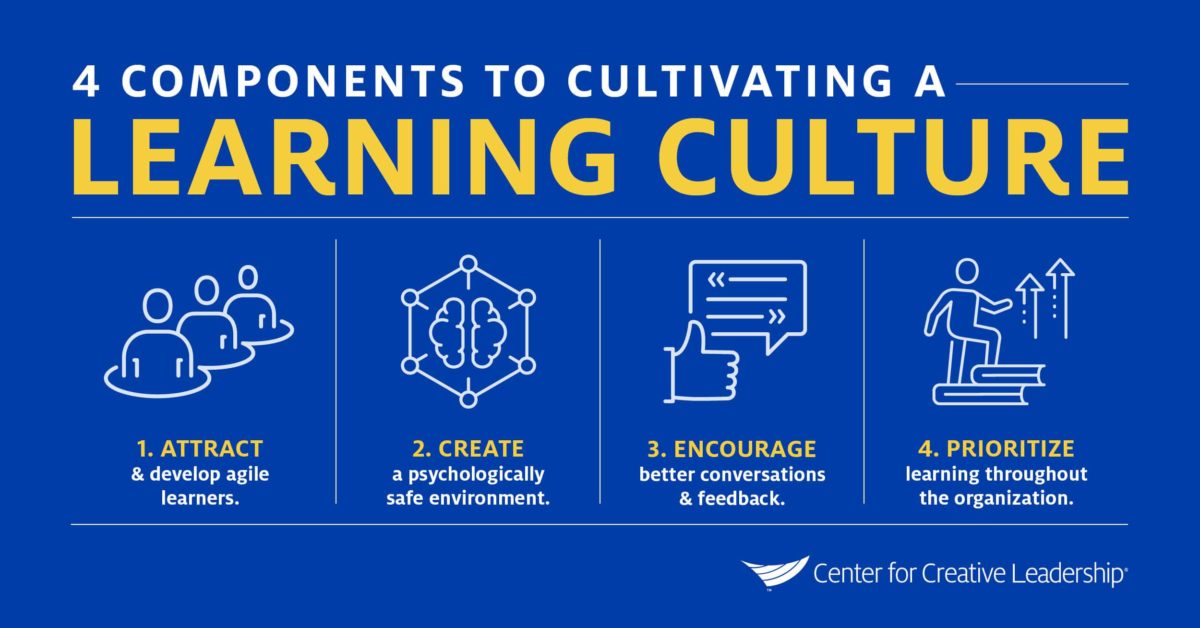How to Create a Learning Culture & Why It’s So Important
Many companies and teams have been affected in some way by what’s been deemed the “Great Resignation.” Whether you’ve personally made a career shift, have scaled back work to care for loved ones during the pandemic, have stepped in to cover your departing colleagues’ responsibilities, or are charged with retaining employees in your organization, we’ve all felt the impact of the staggering statistics of employees resigning.
Many employees are eager to find more meaning or growth in their jobs and are searching for a better place to work, and at the same time, organizations are feeling pressed to find and keep the best talent for the future. To stay competitive in this work environment, organizations must intentionally create cultures that attract, develop, and retain talent so they can successfully execute new strategies for the changing world.
How can your organization create a culture that puts learning at the forefront — in a way that’s practical, behavioral, and scalable — in order to have the greatest impact on employee engagement? It starts with planting seeds for a learning culture to thrive.
What Is a Learning Culture?
A learning culture is an environment that demonstrates and encourages individual and organizational learning, and where both gaining and sharing knowledge is prioritized, valued, and rewarded. It becomes part of the ecosystem of the organization.
While it’s no small feat, there are 4 important components that can help transform your organization’s current culture into a learning culture.
How to Cultivate a Learning Culture at Your Organization
4 Components to Building a Learning Culture
1. Attract and develop agile learners.
If you’re looking to upskill your workforce or perhaps reskill yourself, learning agility is one of the most critical skillsets to develop. Our research at CCL has long shown that the most successful leaders with the longest careers have the key leadership trait of learning agility.
Learning-agile leaders exemplify a growth mindset by learning from experience, challenging perspectives, remaining curious, and seeking new experiences. (Not sure if that’s you? Here’s how to become a more agile learner.)
Because employees with learning agility continue to grow their skills and capabilities regardless of their current job, these individuals are in demand in the quest for talent. The workplace of yesterday no longer exists, and organizations need agile learners who understand how to transfer their current skillset to solve new problems and build capabilities for tomorrow.
- When hiring new talent: Seek out team members who learn from experience and challenge perspectives. Look for the critical skill of learning agility by asking interviewees how they’ve approached difficult situations in the past, how they’ve learned from mistakes, and how they prepare themselves for new challenges. Inquire about how they’ve applied their learnings to their next opportunity.
- For your current team members: Encourage people to remain curious and open. Provide ample opportunities for on-the-job learning and stretch assignments, along with support in the form of tools, mentoring, and coaching. Provide access to development opportunities for employees across your organization — don’t just limit skill-building to a small subset deemed “high potentials.”
Building a learning culture that democratizes leadership development and values a growth mindset will help you attract and retain a workforce that truly wants to learn, and help others learn as well.
2. Create an environment that supports psychological safety.
Looking at the teams and groups in your organization, are you fostering the trust and collaboration needed to sustain a strong learning culture? By creating safe spaces to be open and take interpersonal risks, you can build a foundation of psychological safety at work and encourage the learning that contributes to innovation and productivity.
Psychological safety is about promoting risk-taking and candor in a group, to create a secure environment for optimal learning. It’s the belief that candor is welcome, that employees can ask questions often and early, and that people can freely admit mistakes without fear of retribution.
Encourage team members (especially senior leaders) to admit mistakes openly and share stories of “failing forward.” Also, make sure executives know how to encourage innovation, not unintentionally sabotage and undermine it.
Ensuring leaders can create psychological safety for their teams allows team members to learn collectively and leads to a strong learning culture in your organization, where groups are willing to find lessons in setbacks and hardships, listen to one another, and invite differing opinions and candid conversations.
Remember, it’s not about being polite, but rather about being open. The openness to take interpersonal risks and glean lessons from mistakes to achieve something greater signifies a culture where growth is valued, which leads to a stronger organization that puts learning in the forefront.
Key tips and takeaways:
- Promote risk-taking and transparency within your organization.
- Encourage team members to ask questions often and early.
- Welcome candor and encourage employees, as well as the senior leadership team, to admit mistakes and share lessons learned, without fear of consequence.
Access Our Webinar!
Watch our webinar, How Leaders and Leadership Collectives Can Increase Psychological Safety at Work, and learn how to promote psychological safety to foster trust, creativity, collaboration, and innovation across your organization.
3. Encourage better conversations and feedback throughout the organization.
When determining how to cultivate learning culture, remember that effective communication and feedback should be woven throughout the organization and be encouraged and expected as a part of the norm. When feedback becomes a part of regular conversations, employees are aware of their personal developmental areas, resulting in continuous gains and fewer surprises at end-of-year reviews.
Giving feedback routinely and well often dramatically improves your talent development — but requires a particular skillset, which can fortunately be developed.
Encourage employees to give, and seek, both positive and developmental feedback. Positive feedback can help them leverage what’s working well already, and developmental feedback allows them to see what can be improved upon or done differently to have greater impact.
Because a conversation, by definition, involves 2 or more people, the collective communication competency of an organization is greatly enhanced when all employees are knowledgeable and skilled at holding high-quality conversations. Put simply, better culture starts with better conversations.
And that’s why our clients who have partnered with us to scale our conversational skills training across their organizations have seen such positive results: When a critical mass of people shares a common understanding around what constitutes an effective conversation, it allows new skills to be applied to everyday work, and to spread organically through the organization. Widely applied, improved conversational skills benefit the organization by creating more robust, innovative, stress-tested solutions and a more dynamic and psychologically safe, learning culture.
Key tips and takeaways:
- Improve coaching and conversational skills across your entire organization with research-based, scalable training that helps build a common leadership language.
- Participate in meaningful conversations and provide valuable, actionable feedback.
- Encourage everyone in your organization to listen to one another and seek constructive feedback.
4. Make learning an explicit organizational priority.
If you want to show that learning is a real priority within your organization, send clear signals to your workforce that you’re all in.
Examine your policies, rewards systems, and opportunities to establish and reinforce a learning culture. Consider making these types of scheduled events a common practice at your organization:
- Lunch-and-learns, where senior leaders are storytellers who share their experiences and what they’ve learned recently and throughout their career journeys.
- After-action reviews, where teams regularly take a few minutes to share what they learned from a project or experience.
- Learning communities, where individuals can share what they’ve learned with similarly situated peers, and they can discuss together how they’re applying these learnings in their everyday work.
- Designated development days, where team- or company-wide sharing of lessons learned is expected and honored.
To show that your organization believes that learning is for everyone, make development opportunities inclusive and accessible across the entire organization. The practice of scaling learning will be unique for every organization, but be sure to provide an array of opportunities for “soft skill development” in a wide array of delivery formats to meet learner needs and abilities, including options that are asynchronous, in-person, self-paced, and virtual. (We’ve found that there are many unexpected benefits of using online learning for leadership development.)
Also, to ensure that you’re building a true learning culture, provide organizational support for learning not only in the form of tools and resources, but also by providing the necessary time and space for growth. Encourage leaders to allocate time for themselves and to set aside time for their teams to absorb and practice new skills.
When every employee sees that the organization values both individual and collective growth, you’ll strengthen your learning culture and gain commitment from your team members.
Key tips and takeaways:
- Create a strong learning culture by making it an explicit organizational priority.
- Examine company policies, rewards systems, and career development opportunities — what’s missing and what can be improved?
- Consider making these types of scheduled events a common practice at your organization: lunch-and-learns, after-action reviews, learning communities, designated development days.
Build a Learning Culture That’s Tailored to Your Organization
To tailor your learning strategy to your organization, make sure to align your business strategy and leadership development opportunities, as well as your organization’s broader values, language, and brand. Examine the capabilities needed both today and into the future, and ask employees what type of development would be most valuable for them, as well as how they prefer to learn.
It’s important to acknowledge that not everyone is in a place to jump in right away. Keep in mind that behavior change is difficult. Meet people where they are, encouraging small steps, risk-taking, and sharing through peer support. Use metrics to keep a pulse on what’s resonating and having an impact so that you can adapt as needed and evolve your learning culture strategy as you grow.
Every organization is different, so the path to truly creating a culture of learning that will become a part of the ecosystem will be different as well. But with an intentional focus and commitment from the leadership team, you can plant the seeds today that allow a learning culture to flourish at your organization — resulting in a more agile work environment that’s prepared for the challenges of tomorrow.
Ready to Take the Next Step?
Build a learning culture in your organization by democratizing access to development opportunities. Take advantage of CCL Passport™, which gives you unlimited access to our world-renowned content and our most comprehensive package of proven, transformative leadership solutions. If you license our content, you can bring our proven research, programs, and tools in-house to leaders at all levels of your organization.
Frequently Asked Questions About a Learning Culture
-
Why is a learning culture important?Building a learning culture at your organization is an important factor in attracting, developing, and retaining top talent, particularly during today’s rapidly-changing work environment. Many employees are looking to find more purpose, meaning, and growth opportunities in their jobs, and organizations must deliver. Leadership teams must prioritize the importance of gaining and sharing knowledge, and create equitable access to opportunities for growth and career development.
-
How do you cultivate a learning culture?There are 4 key components to building a learning culture, including attracting and developing agile leaders, creating a psychologically safe environment, encouraging better conversations and candid feedback, and prioritizing learning throughout the organization. Finally, organizations must develop a learning culture that’s tailored to their unique challenges and context, ensuring that their learning strategy aligns with their business strategy as well as their values, brand, and development goals.
-
What is an example of a learning culture?An organization that cultivates a learning culture is one that demonstrates and encourages individual and organizational learning, by both gaining and sharing knowledge. For example, an organization that fosters a learning culture demonstrates psychological safety and may encourage everyone to seek constructive feedback during quarterly one-on-ones or during more casual conversations. Others may host lunch-and-learns where senior leaders share their experiences throughout their career, or they may organize learning communities where individuals can share what they’ve learned with peers. Finally, a company with a strong learning culture may implement designated development days where team- or company-wide sharing is expected and honored. Keep in mind that the most effective learning cultures should implement several of these tactics as opposed to just one.
More questions? Our experts are here to help. Let’s have a conversation!










